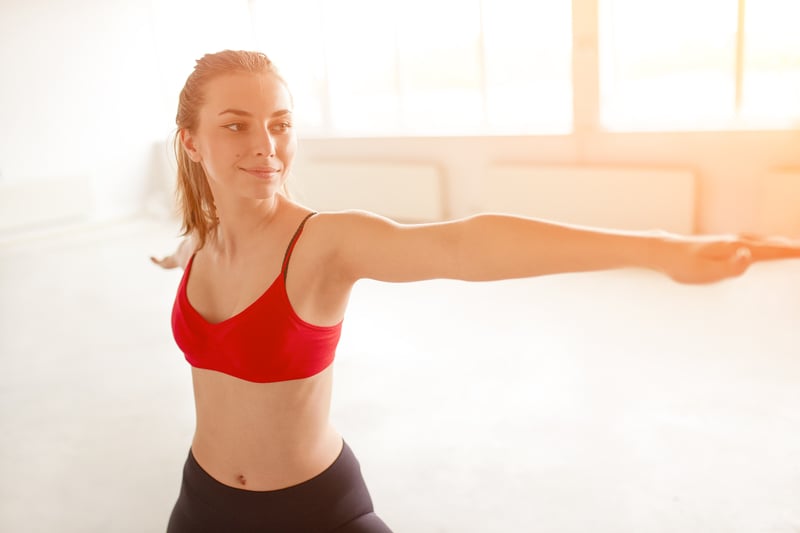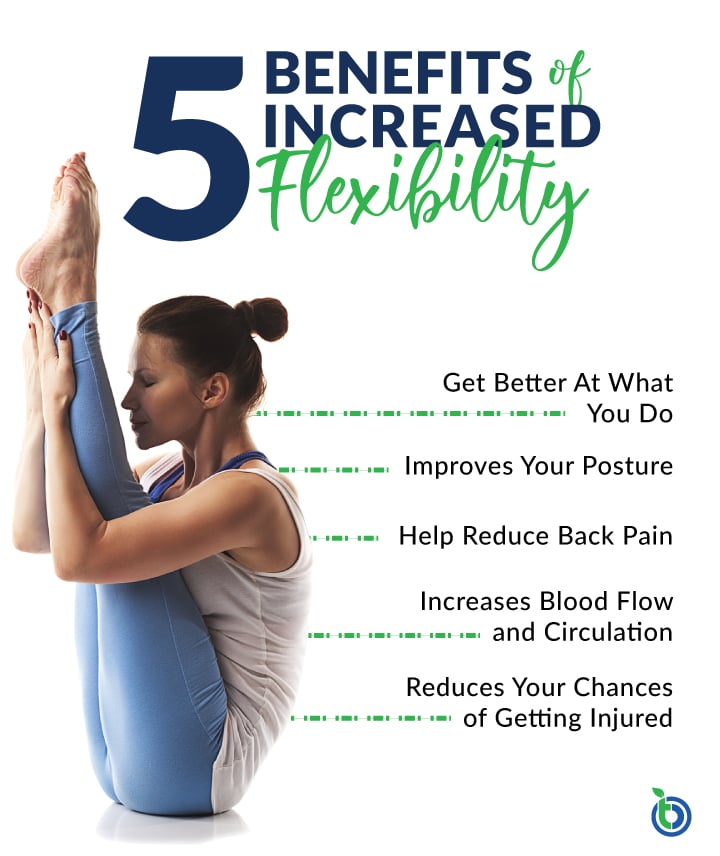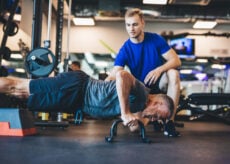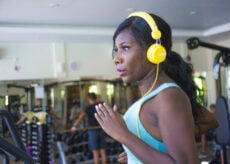How to Become More Flexible (in Just 10 Minutes a Week)

Contrary to popular belief, flexibility is not just about being able to bend over and touch your toes easily. When you become more flexible, you set yourself up for success across the board. Flexibility is a game changer when it comes to feeling good, staying young, and being balanced and healthy.
What is Flexibility?
The term “flexibility” refers to the ability to move your muscles and joints through a full range of motion, preferably without pain. Your flexibility can depend on a number of things, like the natural length of your muscles (longer muscles will provide greater flexibility), how warmed up your muscles are, how often you stretch, and how balanced your body is, among other things.
Three Types of Stretches for Flexibility
- Static—this type of stretch is one that you hold for a specified period. After getting to the top of the stretch, you simply hold the stretch for an allotted period of time.
- Dynamic—these stretches involve movement. Think about doing side bends or neck stretches where you are moving and stretching at the same time.
- Ballistic—these stretches should be used with caution as using “bounce” to help loosen up your muscles is an advanced technique. Use this type of stretch with caution and only after your muscles are fully warmed up. That said, when used correctly, a gentle bounce at the end of your stretch can help increase your ability to stretch further over time.
What are the Benefits of Being Flexible?
Being flexible may well be akin to finding the fountain of youth. There are many benefits that come with stretching, a few of which are:
1. Help reduce back pain. How is this possible? By reducing tension and increasing mobility in your back muscles, glutes, and hip flexors, you can allow your back to relax, reducing stiffness, and alleviating back pain, especially lower back pain. Since a good deal of back pain is produced by misaligned body structures and tightness, providing the stretches and flexibility to release that tension can reduce overall pain.
2. Reduce your chances of getting injured. Yes, when you become more flexible, you boost your chances of operating injury-free. When muscles become tight, joint movements becomes hindered and stiffness can develop. Once you’re dealing with stiffness and tight, short muscles, you may start compensating by overusing or using muscles not normally meant for a specific action. Relying on the wrong muscles too often to perform certain movements can cause misalignment over time, and that is a recipe for injury.
3. Improve your posture. Conversely, when your muscles aren’t tight and restricting movement, you’re free to stand up straight and put your shoulders back, ensuring proper posture and alignment. A balanced body is a healthy body, and this is achieved through regular stretching.
4. Get better at what you do—improving your performance by stretching is a real possibility. When your muscles can fully engage and you can move your joints through their full range of motion, you can get the most out of your training. You’ll see yourself making improvements across the board in all type of sports, from running and swimming to weightlifting and team sports. Regular stretching also improves the mind-body connection and helps you better tune into yourself.
5. Increase blood flow and circulation—stretching regularly can decrease stress and improve the oxygen delivery throughout the body. This benefit is even more important if you spend much of your day seated. As a bonus, the increased circulation can help speed recovery and prevent muscle soreness after exercise.

How Long Should You Hold a Stretch to Become More Flexible?
According to the National Academy of Sports Medicine, to increase flexibility, hold each static stretch for a mere 20 to 30 seconds to help your tight muscles get longer. For even better results, complete 3 sets of each stretch, spending just 10 minutes of total stretching per week.
It also matters when you stretch. For example, if you decide to “stretch” your stretch time to 45 seconds before your workout, you will likely find your strength, power, and speed decrease. (That’s not what you want!) So, keep your stretches under the 30-second mark to allow the muscle to relax, loosen, and stretch without decreasing performance, especially before exercising.
How about after exercise? Again, 30 seconds appears to be the sweet spot if increased flexibility is the goal. That is, unless you’re over 65 years old. Then, the recommendation goes to between 30 and 60 seconds. You could hold a stretch for longer (say, up to five minutes), but it’s likely to just be a waste of time.
If you find your muscles are tight, and you immediately want to back off, then please back off and gently ease into the stretch, taking 45 seconds to a minute to get into the stretch, allowing the muscles to fully relax. Also remember that even with a regular stretching routine, you will likely be more flexible some days than others. Allow your body to be where it is today rather than trying to push past (or into) pain.
No matter how long you hold your stretch, it’s vital to keep breathing throughout. Calm and slow breathing creates space and also provides the oxygen your muscles need to avoid the build up of lactic acid that causes pain. An easy way to ensure you are stretching for around 30 seconds is to count your breaths as you stretch. Shoot for four to six deep breaths in and out.
If you start feeling pain or discomfort, it’s time to stop the stretch. You’ve either pushed too far or have held the stretch too long. With time, you’ll learn your limits and how to reach your edge. But don’t push further. Research has found that low-intensity, gentle stretching is actually more effective for increasing flexibility than more intense, aggressive stretching.

When Should You Stretch?
While morning stretches can feel good, increase blood flow, and improve your mood for the day, don’t just dive in first thing in the morning, especially if you have lower back pain. It takes the body a bit to wake up and for your body’s natural anti-inflammatory chemicals to kick in. So before stretching, give your body some time to wake up (maybe start with a cup of coffee and give it some time to get your blood flowing). Then warm up your muscles by exercising gently for five to ten minutes.
You can stretch anytime throughout the day as long as you take a minute or so to warm up. Your muscles are also more likely to be open and flexible toward the end of the day, so an evening stretching routine can be both relaxing and rewarding.
Finally, make sure you stretch after your workouts as this not only feels good, but also decreases the risk of injury, helps your muscles develop, and reduces muscle soreness.
Try These 6 Movements To Become More Flexible
The goal to become more flexible doesn’t have to be a huge project. You can literally achieve better flexibility by setting aside just a few minutes a day for some relaxing and beneficial stretches. Or, if you can’t dedicate the time, just do the stretches throughout the day whenever you can—though your stretches will be more effective and enjoyable if your body is warm.
1. Shoulder Stretches—begin by standing with your feet about hip-width apart. Next, lift your right arm straight out in front of you and parallel to the floor. Grab your right arm with your left (near the forearm/elbow area) and pull it straight across your chest until you feel a nice stretch throughout your shoulder region. Hold for five breaths and then release. Repeat the process on the other side.
2. Quad Stretch—to stretch the fronts of your legs (the quadriceps), you’ll start by standing with your feet about hip-width apart. You may want to have a chair, wall, table, or counter nearby so you can steady yourself. Bend your knee and pick your right foot off the floor. Grasp your ankle behind you and gently pull your ankle toward your butt until you feel a nice stretch through the front of your thigh. As you’re standing, make sure your lower back is in a neutral position by shifting your hips forward. Hold the stretch for 20 to 30 seconds. Slowly lower your leg back down to the ground and repeat on the opposite side.
3. Glute Bridges—these are stretches that can easily be done in a few minutes but can really help loosen up the hip area. Begin by lying on your back with your knees bent and your hands by your sides. Press your palms into the ground and simultaneously lift your hips off the ground and upward by pushing into your heels as you squeeze your glutes at the top of the movement. Pause for a few seconds and return to the start. Repeat 10 – 15 times.
4. Hanging Hamstring Stretch—this one is easy and effective and feels so nice any time of day. Start by standing with your feet about hip-width apart. Cross your arms in front of you and bend forward at the hips, allowing your crossed arms to hang straight down. Pull your belly in and feel the stretch through your hamstrings, glutes, and low back and hold this stretch for a good five breaths before you return to standing. While you’re bent over, you can also shake your head “no” and nod your head “yes” to help release your shoulders and neck.
5. Side Bends—this stretch will help stretch and loosen your torso: abs and back. Begin by standing with your feet hip-width apart and raise your left arm straight up toward the ceiling. Next, bend your right arm and place your hand on your right hip. With your left arm, reach slowly over your head and toward the right side while moving your hips to the left. Hold for five breaths and repeat on the opposite side.
6. Figure 4—if you spend any amount of time seated at a desk, this stretch can feel heavenly at the end of the day. Start by lying on your back with your head resting on the floor and your knees bent and your feet flat on the floor. Cross your right leg to place your right ankle on your left thigh, just above the knee. Keep your right foot flexed.
Lift your legs off the floor, bringing your left thigh and right ankle toward your chest. Reach your hands on either side of your left leg to pull your thigh in closer to your chest as you use your right elbow to gently press on your right thigh to help open up your hips and glutes. Breathe deeply for a count of five, release, and repeat on the other side.
How to Become More Flexible: A Recap
As with any exercise plan, the goal to become more flexible is a consistent practice. You can do a short and simple stretching routine with the above exercises every day (or nearly every day) and perhaps add other stretches to enjoy a longer stretching routine a couple of days a week.
It is, however, possible to overdo it when it comes to stretching. Only go to your edge. Stretching isn’t a competitive sport. Go to the point where you can feel the stretch but don’t force yourself into a position. You also shouldn’t experience any soreness after stretching. If you do, you pushed too hard or too fast.
After a mere three to six weeks of a consistent stretching routine, you should start to notice and celebrate your increased flexibility!








